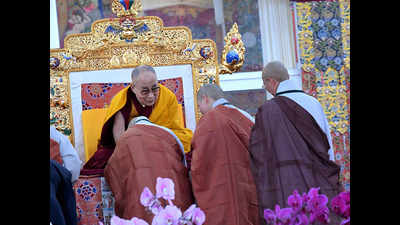Trending
This story is from January 11, 2017
Tibetans use Kalchakra to garner support for autonomy
The avowed purpose of Kalchakra Puja in Bodh Gaya is to inject Buddha traits in ordinary human beings through meditation, spiritual discourse and cleansing of the mind and soul.

Dalai Lama in Bodh Gaya with Korean monks.
GAYA: The avowed purpose of Kalchakra Puja in Bodh Gaya is to inject Buddha traits in ordinary human beings through meditation, spiritual discourse and cleansing of the mind and soul. But the sub-text of the event points to a concerted effort to garner support for autonomy to Tibet and provinces like Qinghai, Sichuan, Gansu and Yunnan, where Tibetan culture has acquired deep roots.
Tibet is currently under Chinese occupation. The Tibetans have used conventional as well as innovative ways to draw attention of the international community towards the problems of Tibetans who want to protect their distinct identity and culture and have been consistently accusing China of being insensitive to their concerns.
Kalchakra, according to Bodh Gaya watchers, presents a good forum to the Tibetans to espouse their cause and paint China with the wrong brush for its alleged atrocities and machinations to hold Tibet under control and tailor the Tibetan culture to ensure it is in sync with main China.
During Kalchakra, whereas the Tibetan PM in exile raised the autonomy issue through the media, a Tibetan group has organised a photo exhibition highlighting alleged Chinese atrocities in Tibet and destruction of Tibet's natural wealth, including forest, on the alibi of development. The atrocity pictures at the exhibition make horrible optics.
Ever since the refuge taken in India by spiritual leader Dalai Lama along with hundreds of thousands of his Tibetan followers in the mid 1950s, the Tibetan issue has defied solution.
Chinese army invaded Tibet in 1950. Several decades later, Karmapa, the second most revered spiritual leader of Buddhists, made a successful escape from Tibet and trekked long mountainous range to find asylum in India. Like the Dalai, the Karmapa too is based at Dharamsala in Himachal Pradesh. Whereas the Dalai and the Tibetan government in exile want autonomy, a group of hardliner Tibetans wants complete freedom for Tibet.
Tibet is currently under Chinese occupation. The Tibetans have used conventional as well as innovative ways to draw attention of the international community towards the problems of Tibetans who want to protect their distinct identity and culture and have been consistently accusing China of being insensitive to their concerns.
Kalchakra, according to Bodh Gaya watchers, presents a good forum to the Tibetans to espouse their cause and paint China with the wrong brush for its alleged atrocities and machinations to hold Tibet under control and tailor the Tibetan culture to ensure it is in sync with main China.
During Kalchakra, whereas the Tibetan PM in exile raised the autonomy issue through the media, a Tibetan group has organised a photo exhibition highlighting alleged Chinese atrocities in Tibet and destruction of Tibet's natural wealth, including forest, on the alibi of development. The atrocity pictures at the exhibition make horrible optics.
The main purpose of the media interaction held by Lobsang Sangay, PM of the Dharamsala-based Tibetan government in exile, a few days back was to highlight the Tibetan autonomy issue and the presence of media representatives from dozens of countries of Europe and Asia provided him the right forum to draw the world’s attention to the Tibet issue.
Ever since the refuge taken in India by spiritual leader Dalai Lama along with hundreds of thousands of his Tibetan followers in the mid 1950s, the Tibetan issue has defied solution.
Chinese army invaded Tibet in 1950. Several decades later, Karmapa, the second most revered spiritual leader of Buddhists, made a successful escape from Tibet and trekked long mountainous range to find asylum in India. Like the Dalai, the Karmapa too is based at Dharamsala in Himachal Pradesh. Whereas the Dalai and the Tibetan government in exile want autonomy, a group of hardliner Tibetans wants complete freedom for Tibet.
End of Article
FOLLOW US ON SOCIAL MEDIA










